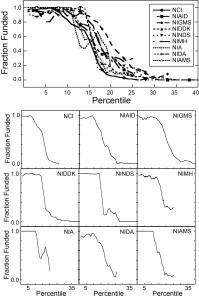Writedit and the Bergster publish a book on NIH grant strategy
November 25, 2013
I cannot wait until my copy of this book arrives.
How the NIH Can Help You Get Funded An Insider’s Guide to Grant Strategy
Michelle L. Kienholz and Jeremy M. Berg
Oxford University Press
ISBN: 9780199989645
Kienholz is, of course, our longstanding blog friend writedit
Michelle Kienholz has partnered with scientists, clinicians, and public health researchers from all disciplines at dozens of universities to develop grant applications for almost every federal agency, including most grant mechanisms for each of the institutes and centers at the NIH. She volunteers her knowledge and experience on her popular blog, Medical Writing, Editing and Grantsmanship (as writedit), through which she has learned the most common and vexing concerns of researchers who interact with the NIH and how best to foster a partnership between investigators and NIH personnel.
and Jeremy Berg, PhD who
joined the University of Pittsburgh in June 2011 as the associate senior vice chancellor for science strategy and planning in the health sciences and a faculty member in the Department of Computational and Systems Biology. Prior, Dr. Berg became director of the National Institute of General Medical Sciences (NIGMS) at the National Institutes of Health (NIH) in November 2003.
is, well, familiar to our readership as the prior head of NIGMS, blogger and provider of much grant-funding data.
Berg recently twitted a teaser graph from the book which finally coughs up a comparison of funding policy for several ICs. According to the Twitter comment it refers to FY 2012 trends.

Nine ICs were willing to cough up data on the percentage of grants funded by the percentile they achieved at study section review. Lower is better, in NIH parlance so you can see that almost everything in the top 7-10% is getting funded across the ICs. Once you get to the top 35th percentile, your chances of funding are almost (but not quite) nil.
What is of best interest here is that we can finally see contrasting IC styles. There are 28 total ICs so this is just a subset but the NCI is huge and the NIMH is no slouch either. The topic domains range from cancer to the brain to metabolic to infectious disease to basic science so there is some breadth there too. I like this as a representative picture although we must always remain suspicious that those who chose not to send the authors their data might have done so for…..reasons.
Anyhow, what jumps out at me first is that NINDS has the sharpest dropoff past their apparent payline. If I am not mistaken, this is precisely the IC that is rumoured to assert their strictness with respect to payline. Strictness involves two choice points of the Program Staff. Whether to skip over grants that fall below (better than) the payline and whether to pick up grants that fall above the payline. Although I do seem to spot some skips under the payline for NINDS, NIA and NIAMS do not appear to have a similar skips. All the other graphs do appear to show skipping behavior. On the other side of “strict payline” behavior, clearly NINDS has funded some grants above their readily apparent payline. It’s just that the distribution drops off much more steeply for them.
I note that NIGMS, NIDA and NIAID seem to have the smoothest curves of pickups away from the apparent payline. The reason I say “apparent” payline is that some institutes, of which NIDA and NIMH are two iirc, insist they do not have a payline. What I have asserted since I noticed Berg’s posting of NIGMS’ funding decisions is that published payline or not, ICs follow roughly the same behavior. These charts demonstrate that. All that differs is the slope of the curve defining above-apparent-payline pickups.
I’m hoping I’ll have more to discuss once my copy of the book arrives.
FDA shuts down 23andMe
November 25, 2013
Wow!
The Food and Drug Administration has ordered DNA testing company 23andMe to stop marketing its over-the-counter genetic test, saying it’s being sold illegally to diagnose diseases, and with no proof it actually works.
I did not see this coming at all. Guess I was too focused on thinking about informed consent issues.